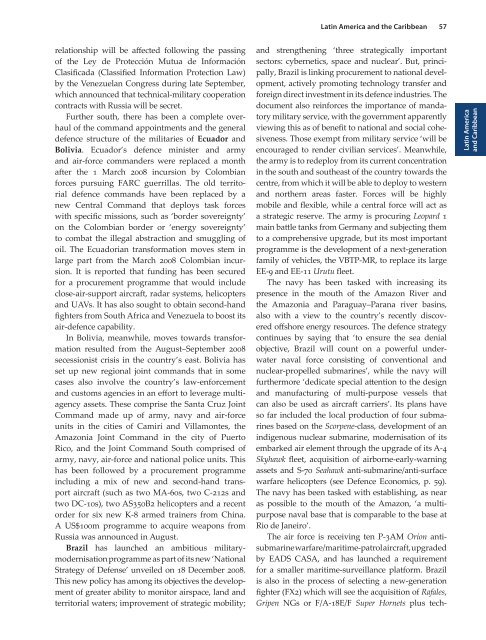Create successful ePaper yourself
Turn your PDF publications into a flip-book with our unique Google optimized e-Paper software.
elationship will be affected following the passing<br />
of the Ley de Protección Mutua de Información<br />
Clasificada (Classified Information Protection Law)<br />
by the Venezuelan Congress during late September,<br />
which announced that technical-military cooperation<br />
contracts with Russia will be secret.<br />
Further south, there has been a complete overhaul<br />
of the command appointments and the general<br />
defence structure of the militaries of Ecuador and<br />
Bolivia. Ecuador’s defence minister and army<br />
and air-force commanders were replaced a month<br />
after the 1 March 2008 incursion by Colombian<br />
forces pursuing FARC guerrillas. The old territorial<br />
defence commands have been replaced by a<br />
new Central Command that deploys task forces<br />
with specific missions, such as ‘border sovereignty’<br />
on the Colombian border or ‘energy sovereignty’<br />
to combat the illegal abstraction and smuggling of<br />
oil. The Ecuadorian transformation moves stem in<br />
large part from the March 2008 Colombian incursion.<br />
It is reported that funding has been secured<br />
for a procurement programme that would include<br />
close-air-support aircraft, radar systems, helicopters<br />
and UAVs. It has also sought to obtain second-hand<br />
fighters from South Africa and Venezuela to boost its<br />
air-defence capability.<br />
In Bolivia, meanwhile, moves towards transformation<br />
resulted from the August–September 2008<br />
secessionist crisis in the country’s east. Bolivia has<br />
set up new regional joint commands that in some<br />
cases also involve the country’s law-enforcement<br />
and customs agencies in an effort to leverage multiagency<br />
assets. These comprise the Santa Cruz Joint<br />
Command made up of army, navy and air-force<br />
units in the cities of Camirí and Villamontes, the<br />
Amazonia Joint Command in the city of Puerto<br />
Rico, and the Joint Command South comprised of<br />
army, navy, air-force and national police units. This<br />
has been followed by a procurement programme<br />
including a mix of new and second-hand transport<br />
aircraft (such as two MA-60s, two C-212s and<br />
two DC-10s), two AS350B2 helicopters and a recent<br />
order for six new K-8 armed trainers from China.<br />
A US$100m programme to acquire weapons from<br />
Russia was announced in August.<br />
Brazil has launched an ambitious militarymodernisation<br />
programme as part of its new ‘National<br />
Strategy of Defense’ unveiled on 18 December 2008.<br />
This new policy has among its objectives the development<br />
of greater ability to monitor airspace, land and<br />
territorial waters; improvement of strategic mobility;<br />
Latin America and the Caribbean<br />
57<br />
and strengthening ‘three strategically important<br />
sectors: cybernetics, space and nuclear’. But, principally,<br />
Brazil is linking procurement to national development,<br />
actively promoting technology transfer and<br />
foreign direct investment in its defence industries. The<br />
document also reinforces the importance of mandatory<br />
military service, with the government apparently<br />
viewing this as of benefit to national and social cohesiveness.<br />
Those exempt from military service ‘will be<br />
encouraged to render civilian services’. Meanwhile,<br />
the army is to redeploy from its current concentration<br />
in the south and southeast of the country towards the<br />
centre, from which it will be able to deploy to western<br />
and northern areas faster. Forces will be highly<br />
mobile and flexible, while a central force will act as<br />
a strategic reserve. The army is procuring Leopard 1<br />
main battle tanks from Germany and subjecting them<br />
to a comprehensive upgrade, but its most important<br />
programme is the development of a next-generation<br />
family of vehicles, the VBTP-MR, to replace its large<br />
EE-9 and EE-11 Urutu fleet.<br />
The navy has been tasked with increasing its<br />
presence in the mouth of the Amazon River and<br />
the Amazonia and Paraguay–Parana river basins,<br />
also with a view to the country’s recently discovered<br />
offshore energy resources. The defence strategy<br />
continues by saying that ‘to ensure the sea denial<br />
objective, Brazil will count on a powerful underwater<br />
naval force consisting of conventional and<br />
nuclear-propelled submarines’, while the navy will<br />
furthermore ‘dedicate special attention to the design<br />
and manufacturing of multi-purpose vessels that<br />
can also be used as aircraft carriers’. Its plans have<br />
so far included the local production of four submarines<br />
based on the Scorpene-class, development of an<br />
indigenous nuclear submarine, modernisation of its<br />
embarked air element through the upgrade of its A-4<br />
Skyhawk fleet, acquisition of airborne-early-warning<br />
assets and S-70 Seahawk anti-submarine/anti-surface<br />
warfare helicopters (see Defence Economics, p. 59).<br />
The navy has been tasked with establishing, as near<br />
as possible to the mouth of the Amazon, ‘a multipurpose<br />
naval base that is comparable to the base at<br />
Rio de Janeiro’.<br />
The air force is receiving ten P-3AM Orion antisubmarine<br />
warfare/maritime-patrol aircraft, upgraded<br />
by EADS CASA, and has launched a requirement<br />
for a smaller maritime-surveillance platform. Brazil<br />
is also in the process of selecting a new-generation<br />
fighter (FX2) which will see the acquisition of Rafales,<br />
Gripen NGs or F/A-18E/F Super Hornets plus tech-<br />
Latin America<br />
and Caribbean


